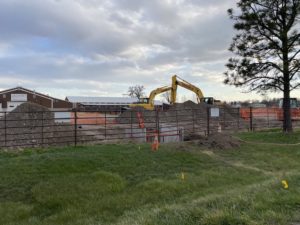By Anne Hedges
 Construction crews at the site of the proposed Yellowstone County Generating Station. Photo by Carah Ronan.
Construction crews at the site of the proposed Yellowstone County Generating Station. Photo by Carah Ronan.
The news from Laurel, Montana, is not good for the climate, the Yellowstone River, or the unfortunate neighbors of NorthWestern Energy’s proposed methane-burning gas plant. NorthWestern recently changed the name of the proposed 175-megawatt power plant to the “Yellowstone County Generating Station” in an apparent attempt to bypass the regulatory oversight of the Laurel City Council. NorthWestern is already living up to the community’s fear that it will be a bad neighbor.
Earlier this year, NorthWestern asked the Yellowstone County Commission to allow it to place a high-pressure methane gas pipeline in the floodplain of the free-flowing Yellowstone River. When it encountered opposition to the pipeline’s original location through a community park and historic site, NorthWestern proposed moving the pipeline’s planned location to one adjacent to numerous residential homes, without notifying the neighbors. The neighbors informed the County that NorthWestern had failed to comply with the law and notify them of the location change. The County then required NorthWestern to notify the neighbors of the new location before it would hold a hearing on the proposal.
That public hearing before the County Commission was held in late March, but throughout three hours of testimony, it became apparent that the hearing was meaningless. The County Commission ignored the thoughtful, technical concerns of neighbors, experts, and advocates for the Yellowstone River. The Commission did not ask a single question of the neighbors or their experts. As soon as the public comment period ended, the Commission asked the floodplain administrator, who had failed to consider the community and technical concerns and had recommended approval of the request, if he had changed his mind. When he replied, “No,” the Commission, without discussion, voted to approve the project in just minutes.
NorthWestern chose one of the most dangerous locations along the river to place its pipeline. It has now run the high-pressure pipeline along the neighbors’ property lines and actually started drilling under the river only 175 feet from a quickly eroding bank on its south side. The north side of the river is rip-rapped, which has contributed to the river moving over 1,000 feet to the south over the last few decades. To make matters worse, NorthWestern cut down dozens of old cottonwood and other trees, eliminating the natural armor of the south bank. These trees had helped stabilize the southern bank for generations.
The Yellowstone River has had numerous pipeline disasters in recent years, including one in the same area. In 2011, an Exxon pipeline was exposed and ruptured after a flood event, damaging water quality and property downstream. Unfortunately, the Yellowstone County Commission seemed more interested in garnering the favor of NorthWestern than that of their own constituents.
Recently, NorthWestern also received a favorable, but inaccurate, assessment of its process when a contract attorney for the City of Laurel overrode the previous opinions of the Laurel city planner and the Yellowstone County planner. She mysteriously concluded that NorthWestern does not need zoning approval from the Laurel City Commission to build the methane gas plant on its proposed site. The troubling decision, if it stands, would eliminate the need for NorthWestern to seek any permission at all from the City of Laurel to build the plant.
Late last year, Earthjustice filed a lawsuit on behalf of MEIC and Sierra Club against the Montana Department of Environmental Quality (DEQ) for its failure to consider the environmental implications of the proposed plant under the Montana Environmental Policy Act when it approved NorthWestern’s air quality permit. We argued that DEQ failed to consider the climate implications of NorthWestern’s proposal as well as the impacts from the increased air pollution, water pollution, pipeline impacts, and the noise of what will be as loud as 18 jet engines along the river near people’s homes. That case is fully briefed and ready for the court to make a decision.
This article was published in the June 2022 issue of Down To Earth.

